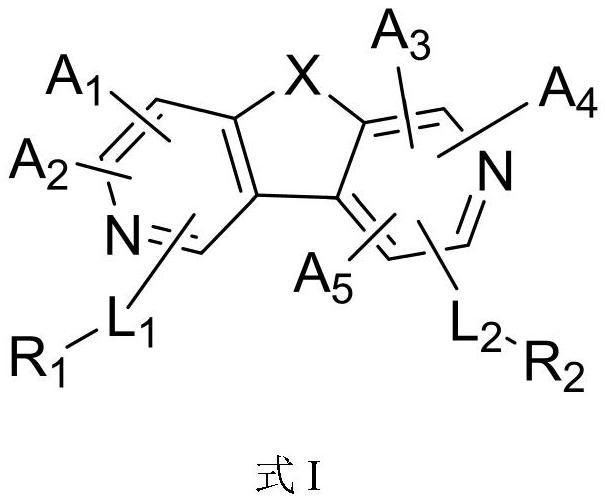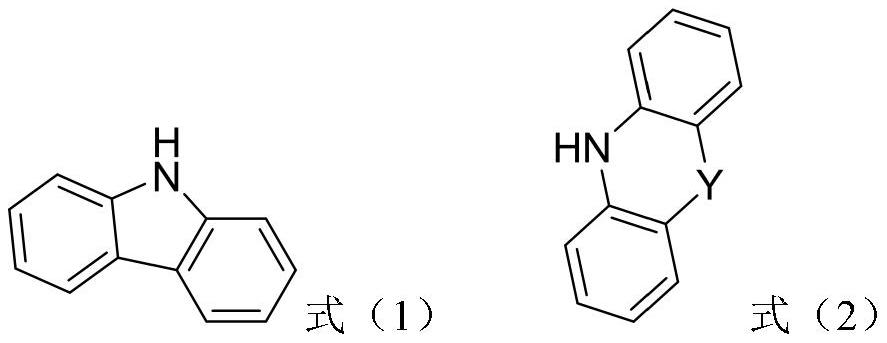Organic compound and application thereof in organic electroluminescent device
An organic compound and alkyl technology, which is applied in the field of organic electroluminescent devices, can solve the problems of high driving voltage and low current efficiency, and achieve the effects of reducing driving voltage, increasing steric hindrance, and reducing injection barriers
- Summary
- Abstract
- Description
- Claims
- Application Information
AI Technical Summary
Problems solved by technology
Method used
Image
Examples
preparation example 1
[0105] Preparation Example 1: Synthesis of Compound 7
[0106]
[0107] Synthesis of Intermediate 7-1: In a 1L three-necked flask, add Intermediate M1 (15g, 68.2mmol), 3-(9H-carbazol-9-yl)phenylboronic acid (21.5g, 75mmol), 200ml isopropyl Alcohol, 10ml of water, anhydrous potassium carbonate (23.5g, 0.17mol) and bis(triphenylphosphine)palladium dichloride (0.5g, 0.7mmol), under the protection of nitrogen, heated and stirred, heated to reflux for 5h, Reduce the reaction to room temperature for liquid separation, take the organic phase and add saturated sodium chloride to wash until neutral, pass the organic phase through silica gel, the eluent is toluene, rinse with 500ml toluene, and spin dry the organic phase after passing through the column A white solid was obtained (yield: 72%).
[0108] Synthesis of Intermediate 7-2: In a 1L three-necked flask, add Intermediate 7-1 (19.2g, 45mmol), pyridine (8.7g, 0.11mol) and 200ml of dichloromethane, and start stirring. Trichlorom...
preparation example 2
[0110] Preparation Example 2: Synthesis of Compound 18
[0111]
[0112] Synthesis of Intermediate 18-1: The synthesis method was the same as that of Intermediate 7-1 to obtain a white solid (yield: 75%). Synthesis of Intermediate 18-2: The synthesis method was the same as that of Intermediate 7-2 to obtain a white solid (yield: 93%). Synthesis of Compound 18: The synthesis method was the same as that of Compound 7 to obtain a white solid (yield: 80%). Mass spectrum: C34H21N3O, theoretical value: 487.17, measured value: 487.2. 1H-NMR (400MHz, CDCl3) (ppm) δ=7.10~7.14 (1H, m), 7.16~7.21 (3H, m), 7.38~7.42 (1H , m), 7.48~7.57 (4H, m), 7.60~7.69 (2H, m), 7.92~7.95 (1H, d), 8.09~8.11 (1H, s), 8.17~8.21 (2H, m), 8.31 ~8.35 (2H, m), 8.47~8.51 (1H, d), 8.53~8.57 (1H, m), 8.59~8.61 (1H, m), 8.85~8.85 (1H, s).
preparation example 3
[0114]
[0115]Synthesis of Intermediate 26-1: The synthesis method was the same as that of Intermediate 7-2 to obtain a white solid (yield: 95%). Synthesis of Compound 26: The synthesis method was the same as that of Compound 7 to obtain a white solid (yield: 76%). Mass spectrum: C34H21N3O, theoretical value: 487.17, measured value: 487.1. 1H-NMR (400MHz, CDCl3) (ppm) δ=7.17~7.21 (2H, m), 7.38~7.42 (1H, m), 7.48~7.52 (2H , m), 7.59~7.78 (6H, m), 7.83~7.89 (3H, m), 8.16~8.21 (1H, m), 8.30~8.31 (1H, d), 8.77~8.51 (1H, d), 8.67 ~8.76 (3H, m), 9.51 ~ 9.52 (1H, s).
PUM
 Login to View More
Login to View More Abstract
Description
Claims
Application Information
 Login to View More
Login to View More - R&D
- Intellectual Property
- Life Sciences
- Materials
- Tech Scout
- Unparalleled Data Quality
- Higher Quality Content
- 60% Fewer Hallucinations
Browse by: Latest US Patents, China's latest patents, Technical Efficacy Thesaurus, Application Domain, Technology Topic, Popular Technical Reports.
© 2025 PatSnap. All rights reserved.Legal|Privacy policy|Modern Slavery Act Transparency Statement|Sitemap|About US| Contact US: help@patsnap.com



